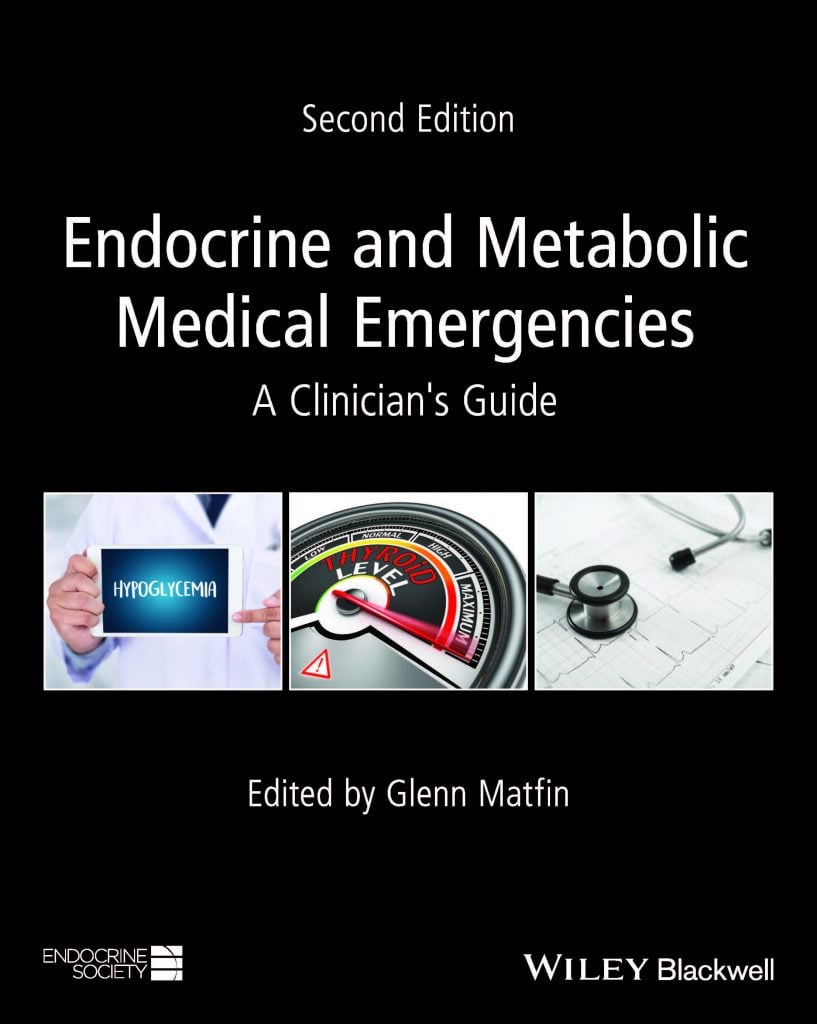
A second edition of Endocrine and Metabolic Medical Emergencies: A Clinician’s Guide, which was first published in 2014, was just released in March.
Once again, Endocrine Society member Glenn Matfin, MSc, Mb ChB, FACE, FRCP, a consultant physician in acute and general internal medicine, diabetes and endocrinology in the UK National Health Service; and Professor of Medicine, MBRU College of Medicine, Dubai, UAE, is serving as the editor of this updated version which provides a singular reference to help endocrinologists, acute and general medicine clinicians, hospitalists and critical care physicians, and general practitioners recognize the symptoms of endocrine emergencies and provide the highest standards of care.
Endocrine News spoke to Matfin about what readers can expect from this new addition and why newer topics were added.
Endocrine News: What was the response to the first edition of Endocrine Emergencies?
Glenn Matfin: Acute clinical care is a major focus for many healthcare providers including endocrinologists. In addition, patients with endocrine and metabolic emergencies constitute a large proportion of this general and specialist clinical workload. Unfortunately, many patients are not ideally managed due to the lack of excellent, up-to-date, and practical guidance. There is therefore an unmet need for a comprehensive clinician resource covering acute endocrine and metabolic emergencies. As the Endocrine Society is a world-leader in education and translation of clinical endocrinology, it was understandable that this unmet need be addressed by the Endocrine Society. The first edition of Endocrine and Metabolic Medical Emergencies was published by Endocrine Press (publishing imprint of the Endocrine Society) in 2014. The purpose of the original and updated editions was to help fill this knowledge gap by collating existing evidence and best practice on the management of numerous everyday endocrine and metabolic emergencies facing clinicians.
The response to the first edition was very positive. It clearly helped to close this previously unmet educational and clinical practice need and hopefully translated into improved patient experience and outcomes. On another positive note, several endocrine training programs gave fellows a copy of this book on graduation. This is indirect support for the book’s unique content, format and utility. Ultimately, the book has progressed into an expanded second edition, which suggests it did (at least in part) fulfill its original objectives.
Many patients with diabetes and endocrine issues/emergencies are not ideally managed in the acute care setting leading to unwarranted clinical variation.
EN: What has been updated in this second edition?
GM: This expanded edition has been updated completely (with final edits into early 2018). The size and scope of the text has also increased with an approximate doubling in the number of pages (from 440 pages to 840) and larger page size. The second edition of the book has several new features including key points; case studies, and many new figures. Several special populations of patients discussed in the first edition (i.e. the unique impact of aging, pregnancy, and HIV/AIDS on emergency endocrine and metabolic disorders presentation and management), have been expanded in the second edition to include new chapters on endocrine and metabolic emergencies in transitional care; perioperative; late-effects; inherited metabolic diseases; and transplantation patients. Several additional new chapters have been added throughout the book; and new authors have updated some of the previous chapters.

EN: Have you gotten any feedback on particular chapters that have proven to have had a real impact on patient care?
GM: The chapters with the most potential impact on patient care generally address the most common presentations in the acute care setting (e.g. hyponatremia; hypercalcemia; and all things diabetes-related including hypoglycemia). In addition, many of the chapters are written by leading thought leaders in the subject area. They have delivered the definitive, most accessible, jargon-free clinician resource for learning/updating clinical knowledge about their specific topic(s). Lastly, some chapters cover the thorny issues which are especially taxing to the clinician or areas not often addressed in other publications (such as the management of insulin pumps or concentrated insulin in the inpatient setting).
The response to the first edition was very positive. It clearly helped to close this previously unmet educational and clinical practice need and hopefully translated into improved patient experience and outcomes.
EN: What is the most misunderstood component of endocrine emergencies?
GM: Many patients with diabetes and endocrine issues/emergencies are not ideally managed in the acute care setting leading to unwarranted clinical variation. This can be due to many factors including lack of time, training and/or expertise among healthcare providers. For example, many clinicians (especially junior doctors and non-endocrine specialists) believe that patients presenting with various emergency endocrine and metabolic disorders with abnormal values (e.g. level of glucose, sodium, osmolality, anion gap [“closing the gap”], and blood pressure) must be corrected to “normal” as quickly as possible. This practice can lead to increased morbidity and mortality (e.g. osmotic demyelination syndrome with over-rapid correction of hyponatremia). Preventing rapid- and over-correction by appropriate education, guidelines, care pathways, audit, and other resources (such as this book) may reduce unnecessary suffering and potentially save lives.
You can order Endocrine and Metabolic Medical Emergencies: A Clinician’s Guide, 2nd Edition online.

